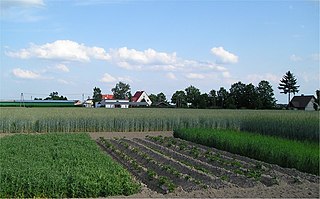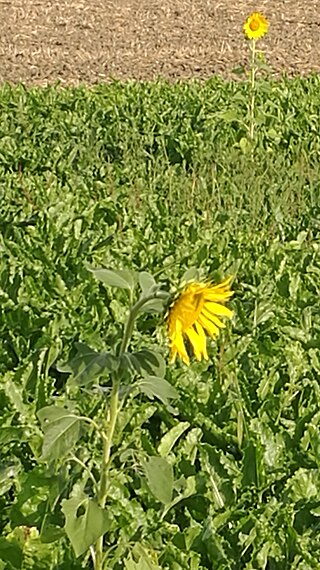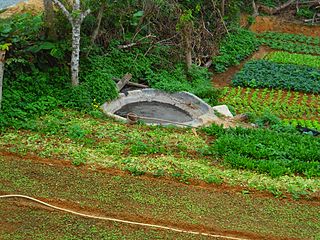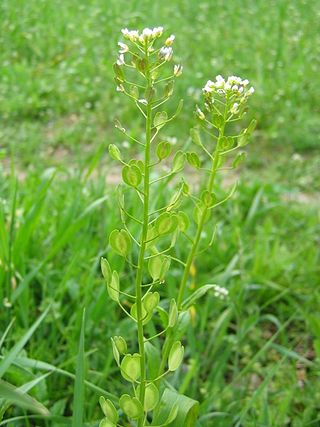Related Research Articles

Crop rotation is the practice of growing a series of different types of crops in the same area across a sequence of growing seasons. This practice reduces the reliance of crops on one set of nutrients, pest and weed pressure, along with the probability of developing resistant pests and weeds.

In gardening and agronomic terminology, a volunteer is a plant that grows on its own, rather than being deliberately planted by a farmer or gardener. The action of such plants — to sprout or grow in this fashion — may also be described as volunteering.

Alfalfa, also called lucerne, is a perennial flowering plant in the legume family Fabaceae. It is cultivated as an important forage crop in many countries around the world. It is used for grazing, hay, and silage, as well as a green manure and cover crop. The name alfalfa is used in North America. The name lucerne is more commonly used in the United Kingdom, South Africa, Australia, and New Zealand. The plant superficially resembles clover, especially while young, when trifoliate leaves comprising round leaflets predominate. Later in maturity, leaflets are elongated. It has clusters of small purple flowers followed by fruits spiralled in two to three turns containing 10–20 seeds. Alfalfa is native to warmer temperate climates. It has been cultivated as livestock fodder since at least the era of the ancient Greeks and Romans.

Intensive agriculture, also known as intensive farming, conventional, or industrial agriculture, is a type of agriculture, both of crop plants and of animals, with higher levels of input and output per unit of agricultural land area. It is characterized by a low fallow ratio, higher use of inputs such as capital, labour, agrochemicals and water, and higher crop yields per unit land area.

Horticulture is the cultivation of plants in gardens or greenhouses, as opposed to the field-scale production of crops characteristic of agriculture. It includes the cultivation of fruits, vegetables, nuts, seeds, herbs, sprouts, mushrooms, algae, flowers, seaweeds and non-food crops such as grass and ornamental trees and plants. It also includes plant conservation, landscape restoration, landscape and garden design, construction, and maintenance, and arboriculture, ornamental trees and lawns.

A legume is a plant in the family Fabaceae, or the fruit or seed of such a plant. When used as a dry grain, the seed is also called a pulse. Legumes are grown agriculturally, primarily for human consumption, for livestock forage and silage, and as soil-enhancing green manure. Well-known legumes include beans, soybeans, chickpeas, peanuts, lentils, lupins, grass peas, mesquite, carob, tamarind, alfalfa, and clover. Legumes produce a botanically unique type of fruit – a simple dry fruit that develops from a simple carpel and usually dehisces on two sides.

No-till farming is an agricultural technique for growing crops or pasture without disturbing the soil through tillage. No-till farming decreases the amount of soil erosion tillage causes in certain soils, especially in sandy and dry soils on sloping terrain. Other possible benefits include an increase in the amount of water that infiltrates into the soil, soil retention of organic matter, and nutrient cycling. These methods may increase the amount and variety of life in and on the soil. While conventional no-tillage systems use herbicides to control weeds, organic systems use a combination of strategies, such as planting cover crops as mulch to suppress weeds.
Agribusiness is the industry, enterprises, and the field of study of value chains in agriculture and in the bio-economy, in which case it is also called bio-business or bio-enterprise. The primary goal of agribusiness is to maximize profit while satisfying the needs of consumers for products related to natural resources such as biotechnology, farms, food, forestry, fisheries, fuel, and fiber.

Detasseling corn is removing the pollen-producing flowers, the tassel, from the tops of corn (maize) plants and placing them on the ground. It is a form of pollination control, employed to cross-breed, or hybridize, two varieties of corn.

Organic fertilizers are fertilizers that are naturally produced. Fertilizers are materials that can be added to soil or plants, in order to provide nutrients and sustain growth. Typical organic fertilizers include all animal waste including meat processing waste, manure, slurry, and guano; plus plant based fertilizers such as compost; and biosolids. Inorganic "organic fertilizers" include minerals and ash. The organic-mess refers to the Principles of Organic Agriculture, which determines whether a fertilizer can be used for commercial organic agriculture, not whether the fertilizer consists of organic compounds.
Non-pesticidal Management (NPM) describes various pest-control techniques which do not rely on pesticides. It is used in organic production of foodstuff, as well as in other situations in which the introduction of toxins is undesirable. Instead of the use of synthetic toxins, pest control is achieved by biological means.

Thlaspi arvense, known by the common name field pennycress, is a flowering plant in the cabbage family Brassicaceae. It is native to Eurasia, and is a common weed throughout much of North America and its home.

Intensive crop farming is a modern industrialized form of crop farming. Intensive crop farming's methods include innovation in agricultural machinery, farming methods, genetic engineering technology, techniques for achieving economies of scale in production, the creation of new markets for consumption, patent protection of genetic information, and global trade. These methods are widespread in developed nations.

A weed is a plant considered undesirable in a particular situation, growing where it conflicts with human preferences, needs, or goals. Plants with characteristics that make them hazardous, aesthetically unappealing, difficult to control in managed environments, or otherwise unwanted in farm land, orchards, gardens, lawns, parks, recreational spaces, residential and industrial areas, may all be considered weeds. The concept of weeds is particularly significant in agriculture, where the presence of weeds in fields used to grow crops may cause major losses in yields. Invasive species, plants introduced to an environment where their presence negatively impacts the overall functioning and biodiversity of the ecosystem, may also sometimes be considered weeds.
Crop diversity or crop biodiversity is the variety and variability of crops, plants used in agriculture, including their genetic and phenotypic characteristics. It is a subset of and a specific element of agricultural biodiversity. Over the past 50 years, there has been a major decline in two components of crop diversity; genetic diversity within each crop and the number of species commonly grown.

Perennial rice are varieties of long-lived rice that are capable of regrowing season after season without reseeding; they are being developed by plant geneticists at several institutions. Although these varieties are genetically distinct and will be adapted for different climates and cropping systems, their lifespan is so different from other kinds of rice that they are collectively called perennial rice. Perennial rice—like many other perennial plants—can spread by horizontal stems below or just above the surface of the soil but they also reproduce sexually by producing flowers, pollen and seeds. As with any other grain crop, it is the seeds that are harvested and eaten by humans.

Plant breeding is the science of changing the traits of plants in order to produce desired characteristics. It has been used to improve the quality of nutrition in products for humans and animals. The goals of plant breeding are to produce crop varieties that boast unique and superior traits for a variety of applications. The most frequently addressed agricultural traits are those related to biotic and abiotic stress tolerance, grain or biomass yield, end-use quality characteristics such as taste or the concentrations of specific biological molecules and ease of processing.
Mutation breeding, sometimes referred to as "variation breeding", is the process of exposing seeds to chemicals, radiation, or enzymes in order to generate mutants with desirable traits to be bred with other cultivars. Plants created using mutagenesis are sometimes called mutagenic plants or mutagenic seeds.

In agriculture, shattering is the dispersal of a crop's seeds upon their becoming ripe. From an agricultural perspective this is generally an undesirable process, and in the history of crop domestication several important advances have involved a mutation in a crop plant that reduced shattering—instead of the seeds being dispersed as soon as they were ripe, the mutant plants retained the seeds for longer, which made harvesting much more effective. Non-shattering phenotype is one of the prerequisites for plant breeding especially when introgressing valuable traits from wild varieties of domesticated crops.
This glossary of agriculture is a list of definitions of terms and concepts used in agriculture, its sub-disciplines, and related fields, including horticulture, animal husbandry, agribusiness, and agricultural policy. For other glossaries relevant to agricultural science, see Glossary of biology, Glossary of ecology, Glossary of environmental science, and Glossary of botanical terms.
References
- ↑ Mosley, A; Gutbrod, McMorran (2001-05-16). "Roguing seed potatoes" (PDF). Oregon State University . Retrieved 2009-06-25.
- ↑ Colley, Micaela (2009-01-19). "Selection and Roguing in Organic Seed Production". Organic Seed Alliance. Archived from the original on 2013-04-14. Retrieved 2009-06-25.
- ↑ Agricultural Seed Production By Raymond A. T. George